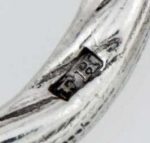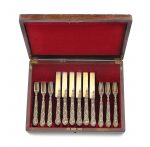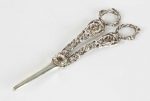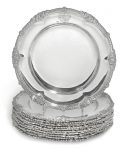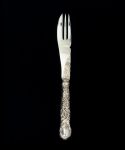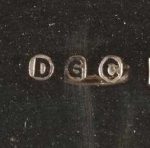Francis Higgins was born in 1818 and died in 1908. Francis Higgins & Son rose to great prominence in the silver trade for the quality and ingenuity of their work as specialist spoon and fork makers. Reference: Victoria & Albert Museum.
Francis Higgins silver makers mark
A cased set of silver-gilt vine pattern dessert knives and forks by Francis Higgins, London 1871 Comprising six knives and six forks, crested, in a wood box, length 33cm.
Sold for £ 562 inc. premium at Bonhams in 2018
A VICTORIAN SILVER PRESENTATION SPADE MARK OF FRANCIS HIGGINS, LONDON, 1852 The blade engraved with coat-of-arms between crests within flowing foliate tendrils, with a view of Seaham harbour and presentation inscription, the ivory shaft terminating in a silver handle 38 in. (96.5 cm.) long Higgins, F. The arms are those of Vane quartering Stewart accolé with Vane quartering Stewart with Vane in pretence for Charles William Vane, 3rd Marquess of Londonderry (1778-1854) and his second wife Lady Frances Anne Vane-Tempest, daughter and heiress of Sir Henry Vane-Tempest, who he married in 1819. Lord Londonderry took the surname of Vane, by royal licence, and used his new bride’s immense wealth to acquire the Seaham Hall estate in County Durham with a view to developing the coal fields there. The inscription reads ‘This spade / was used by / Charles William Vane / Marquis of Londonderry K.G., G.C.B. / to cut the first sod / of the / Londonderry Seaham / and / Sunderland Railway / on the 8th of February / 1853.’
Sold for A VICTORIAN SILVER PRESENTATION SPADE MARK OF FRANCIS HIGGINS, LONDON, 1852 at Christies in 2014
Francis Higgins, London, Sterling Silver Figural Grape Scissors. c. 1860. 4.5 ozt. L 7 1/2″ W 2 1/2″.
Sold for $200 at Cottone Auctions in 2018
A set of twenty-four Victorian silver second course plates, Francis Higgins for Francis Higgins & Son, London, 1889 oak shell embellished gadrooned rims, engraved with a coat-of-arms 26cm., 10 1/4 in. diameter 16913gr., 543oz.
Sold for 11,250 GBP at Sothebys in 2017
The pastry fork was a Victorian invention. The complicated dining etiquette of the period encouraged the development of specific utensils for eating particular foods. Pastry-based desserts were always eaten with a fork. The Habits of Good Society, written around 1859 to give guidance on etiquette, was adamant on the use of a fork for this purpose. ‘ What! A knife to cut that light, brittle pastry? No, nor fingers, never. Nor a spoon – almost as bad. Take your fork, sir, your fork!’ Pastry forks had one broader prong (or tine) with a sharper, blade-like edge for cutting.
The pattern on the handle of the fork is known as Vine and was popular for decorating dessert ware from its introduction in the early 19th century.
Reference: © Victoria and Albert Museum
